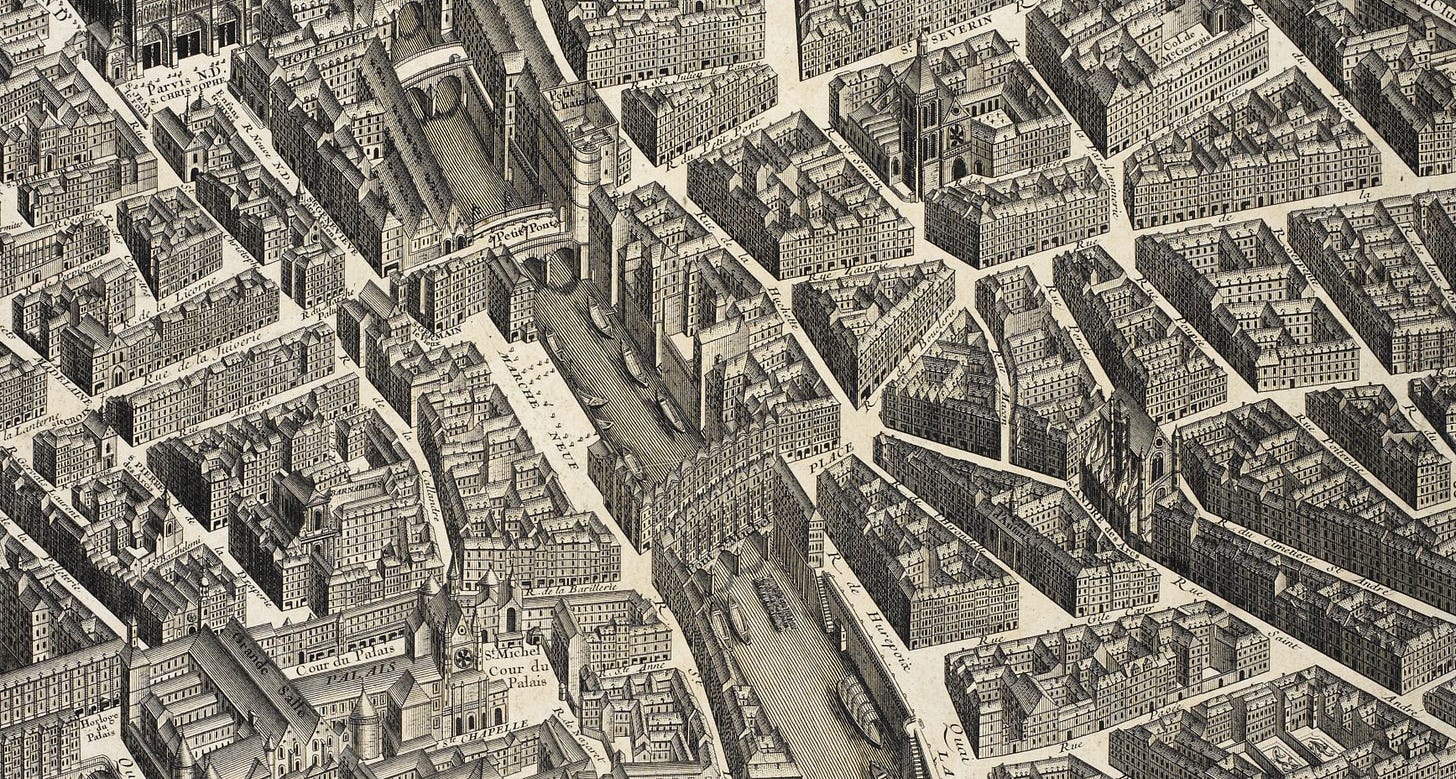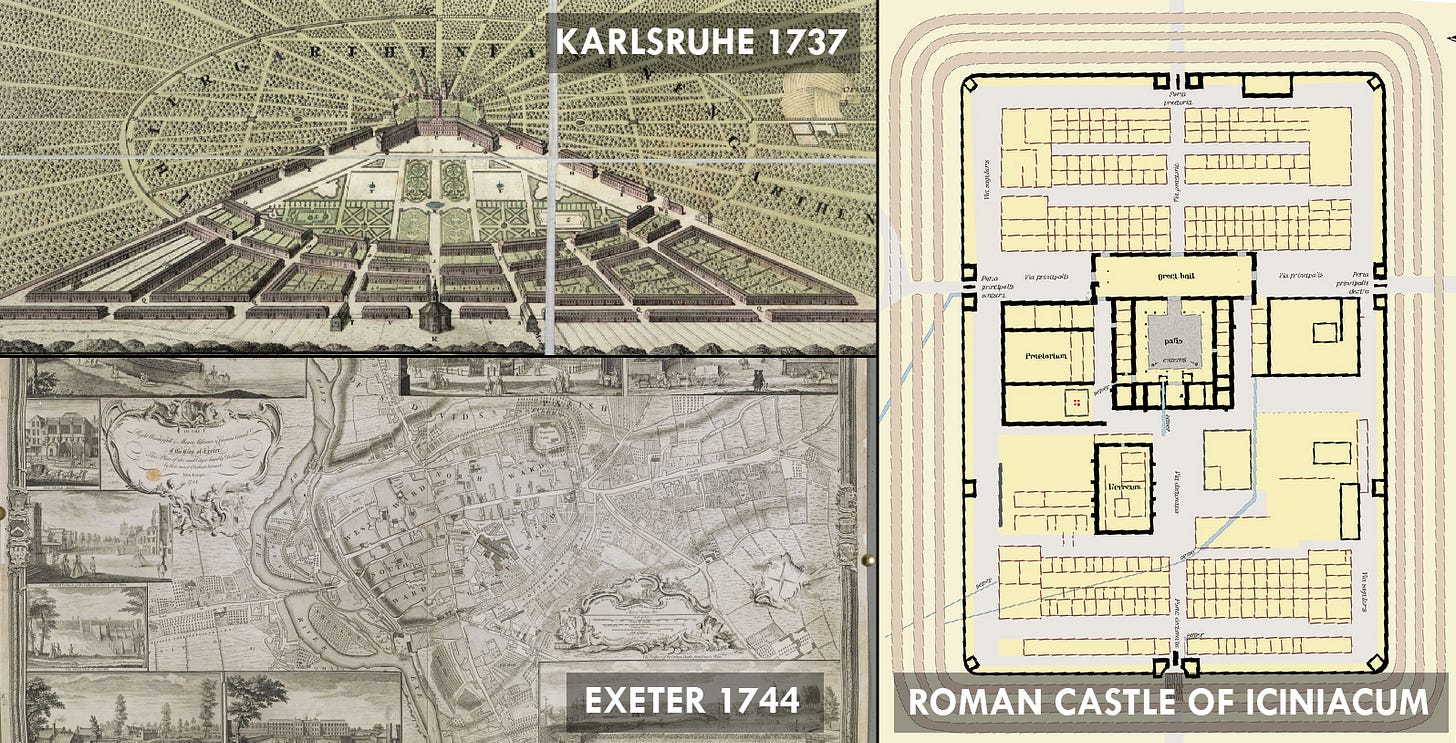Pre-baroque medieval cities exhibit a particular sensibility to meandering paths combined with dense urban form. Similar to middle-eastern medinas, there is a general sense of disorder and confusion. They lack the straight lines and right angles which we have grown up adulating as exemplary expressions of order. Scott elucidates how Euclidian patterns first start appearing in the form of defensive walls and moats - with “traces of inner walls superseded by outer walls, much like the growth rings of a tree”. A good example of this is Vienna’s Ringstraße where the old city defenses were later dismantled and transformed into a wide ring road peppered with parks and amenities.
The informal urban sublime changed when European city-states were required to field large and organized armies. They learned from the Romans, whom understood the importance of legibility in planning their castra: the fortified military camps found throughout the ancient empire. This sense of abstraction was imported to urban centers through a military mindset that generated straight avenues, wide boulevards and concentric ring roads. Abstracted further, geometry became the framework which now guides the growth of cities: the urban grid. This shift in how cities were built was also reflected in their cartographic projection, with maps becoming flatter and losing the playful perspectives that used to characterize them.
When the Prussian Soldier King expanded his army in Berlin, he built new squares and avenues: they served as parade-grounds for the military, which by 1740 comprised 25% of the city’s population. These changes erased the street-level secrecy that medieval towns typically reserved for locals - they made a city easier to traverse for foreigners: both friends and foes. That’s also the main reason why post-revolutionary France carefully mapped all its cities through reconnaissances militaires enabling authority to act quickly in case of rebellions.
While the French military mapped, Baron Haussmann intervened. His wide Parisian corridors represent an always-current standard of beauty & good planning to most non-specialist eyes. While one cannot argue against the intricate aesthetic values of the city of lights, it is more important to digest the boulevards and green spaces as urban/social re-engineering: they enabled military control in a typically rebellious and easy to barricade city. In Rebel Cities, David Harvey gives larger meaning to the wide highways separating impoverished American inner-city neighborhoods from high-value downtown properties. He interprets them as a defensive response to the uprisings of the 60s. Large-scale urban projects are less about the infrastructure, more about the ideology.
In 2002 Marine Corps Lieutenant General Paul K. Van Riper was leading underdog red team in the MC02 war game exercise. Costing more than US$250 million MC02 was “meant to be a test of future military transformation - a transition toward new technologies that enable network-centric warfare.” The 752-pages report however describes how Riper overcame his overwhelming disadvantage and temporarily disrupted the status quo. He adopted an asymmetric strategy: using motorcycle messengers to evade electronic surveillance, light signals to silently launch airplanes, guerilla tactics and suicide attacks. He pre-emptively destroyed sixteen warships which - in a real conflict - would have resulted in the deaths of more than 20,000 personnel. The military reset the war game and required red team to follow a losing script which reinforced the traditional military doctrine that had so spectacularly failed. Riper resigned. We seem to be designing our cities similarly to how the military designs it’s failed exercises. If we don’t adopt a tactical, asymmetric approach to urban growth, we are bound to fail through grand-scale strategic propositions.
One Book
Rebel Cities by David Harvey\ A thorough description of urbanization, urban development and construction through a Marxist perspective. Has capital grounded itself in cities? The book is a collection of different essays written by Harvey on the city. He is spectacular in the “Art of Rent” chapter not only in the theoretical backing but also in its lucid case studies: the wine market, Barcelona, and the commodification of culture by amassing collective symbolic capital. Harvey describes different ideas on the organization of a new kind of city and even offers a few of his own. A short yet extremely interesting book.
Three Links
The Network: How a Secretive Phone Company Helped the Crime World Go Dark by Joseph Cox\ On the darker aspects of encryption.
Uber’s Self-Driving Car Killed Someone. Why Isn’t Uber Being Charged? by Jesse Halfon\ It’s all fun and games until algorithms start killing people.
Why didn’t I become an architect? by Orhan Pamuk\ On how Pamuk manages to verbalize what is struggling to escape the back of your mind.
Five Tweets
To love anything is to love its boundaries.
— G. K. Chesterton (@GKCdaily) October 26, 2020
The most detailed map ever of the orbits of galaxies in our extended local neighborhood, showing the past motions of almost 1400 galaxies within 100 million light years of the Milky Way https://t.co/Q8lyy1Zde2 pic.twitter.com/ewjYX20jM8
— Massimo (@Rainmaker1973) October 26, 2020
Why would you have been committed to a 19th century asylum? I’ll go with “vicious vices.” pic.twitter.com/tJI9A1uASJ
— Tim Urban (@waitbutwhy) October 25, 2020
Colton's iconic mountains & rivers map - shows comparative lengths of the world's rivers & heights of mountains by region & continent. Includes detail on vegetation, volcanic activity, illustrations of major cities & lakes with relative altitudes | @DavidRumseyMaps #cartography pic.twitter.com/ZfauxlIlYN
— Bellerby Globemakers (@globemakers) October 23, 2020
We need to radically rethink how we structure our tax and financial systems and accept that home ownership may not always be the solution, argues @jryancollins in this talk based on his book "Why Can't You Afford a Home?", chaired by @DawnHFoster. https://t.co/GgDlNwAWRV
— Institute for Innovation and Public Purpose (@IIPP_UCL) October 22, 2020
This was the sixth issue of Think Think Think - a periodic newsletter by Joni Baboci on cities, science and complexity. If you really liked it why not subscribe?




